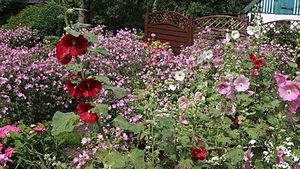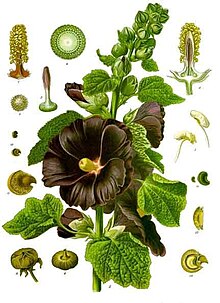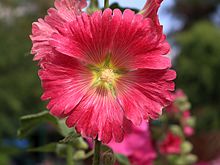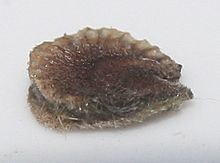Common hollyhock
| Common hollyhock | ||||||||||||
|---|---|---|---|---|---|---|---|---|---|---|---|---|

Common hollyhocks ( Alcea rosea ) in the foreground |
||||||||||||
| Systematics | ||||||||||||
|
||||||||||||
| Scientific name | ||||||||||||
| Alcea rosea | ||||||||||||
| L. |
The common hollyhock ( Alcea rosea ), also called hollyhock , garden poplar rose , farm rose or garden hollyhock , is a species of the genus hollyhocks ( Alcea ) within the mallow family (Malvaceae). Many varieties are used as ornamental plants .
description
Vegetative characteristics
The Alcea rosea is a two year to short-lived perennial herbaceous plant , the growth heights of 1 to 2, often up to 3 meters achieved. The above-ground parts of the plant usually have star hairs . The stem is strong, upright, hardly branched and densely wire-haired.
The leaves are arranged in a basal rosette in the first year and distributed on the stem in the second year and are divided into a petiole and a leaf blade. The petiole is 5 to 15 centimeters long and has star hairs. The almost circular leaf blade with a diameter of 6 to 16 centimeters is tomentose to woolly hairy, weakly three to seven lobes, sometimes also notched. The middle leaf lobe is about 3 inches long and 4 to 6 inches wide. The ovoid stipules are about 8 millimeters long, ovate and three-lobed.
Generative characteristics
The flowering period extends from February to October, depending on the location. The flowers stand individually or in groups in the upper leaf axils and in a terminal spike-like inflorescence . The bracts resemble the foliage leaves. The hairy flower stalks are about 5 millimeters long and extend to 8 to 10 millimeters by the time the fruit is ripe.
The showy flowers are hermaphroditic and radial symmetry . The cup-shaped outer calyx is usually six to seven lobed, 8 to 10 millimeters long and is densely covered with star hair. The five densely tomentose sepals are fused together like a bell, the calyx has a diameter of 2 to 3 centimeters and the calyx tips are 1.2 to 1.5 centimeters long. The corolla has a diameter of 6 to 10 centimeters. The five free, 4 centimeters long, nailed petals are pink to purple or blackish red, rarely white or yellow. The stamen tube is bare and about 2 centimeters long and the free areas of the stamen are only about 2 millimeters long. The many-branched style is hairy downy.
The downy hairy split fruit is disc-shaped with a diameter of about 2 centimeters. The many (20 to 40) almost circular partial fruits have a diameter of 7 to 8 millimeters and are longitudinally ribbed.
The number of chromosomes is 2n = 42.
ecology
The flowers of the common hollyhock are mainly approached and pollinated by bumblebees . It is infested with uredia from the mallow rust.
origin
The common hollyhock may come from the Balkans or southern Italy. She is probably a hybrid of cultures . The pale hollyhock ( Alcea biennis ) is believed to be the tribe.
Taxonomy
The scientific name Alcea rosea was first published in 1753 by Carl von Linné in Species Plantarum . Important synonyms for Alcea rosea L. are Althaea rosea (L.) Cav. and Althaea sinensis Cav.
use
There are numerous varieties of common hollyhock with single and double flowers of different colors. It is widely used as an ornamental plant for perennial beds and cottage gardens.
It is seldom grown as a medicinal and coloring plant. Only black and red variants are used for the production of colorants , as their petals contain anthocyanins ( malvidin ) in large quantities. It used to be used to color wine, liqueur, desserts, food and textiles, for example, today it is no longer relevant. The plant can be used to color purple-blue to gray. Due to the tannin and mucilage contained in the common hollyhock, it is contained in numerous cough tea mixtures.
literature
- Ya Tang, Michael G. Gilbert, Laurence J. Dorr: Malvaceae. In: Wu Zheng-yi, Peter H. Raven, Deyuan Hong (Eds.): Flora of China . Volume 12: Hippocastanaceae through Theaceae . Science Press / Missouri Botanical Garden Press, Beijing / St. Louis 2007, ISBN 978-1-930723-64-1 , Alcea rosea , p. 267 (English, online ). (Section description)
- Sultanul Abedin: Flora of West Pakistan 130. Malvaceae. Stewart Herbarium, Rawalpindi, 1979, Alcea rosea , (online). (Section description)
- Susanne Bickel-Sandkötter: Useful plants and their ingredients. Quelle & Meyer, Wiebelsheim 2001, ISBN 3-494-02252-6 .
- Eckehart J. Jäger, Friedrich Ebel, Peter Hanelt, Gerd K. Müller (eds.): Excursion flora from Germany . Founded by Werner Rothmaler. tape 5 : Herbaceous ornamental and useful plants . Springer, Spektrum Akademischer Verlag, Berlin / Heidelberg 2008, ISBN 978-3-8274-0918-8 .
Web links
- Common hollyhock . In: BiolFlor, the database of biological-ecological characteristics of the flora of Germany.
- Alcea rosea L., garden hollyhock. In: FloraWeb.de.
- Profile and distribution map for Bavaria . In: Botanical Information Hub of Bavaria .
- Distribution map for Germany. In: deutschlandflora.de (Network Phytodiversity Germany eV).
- Alcea rosea L. In: Info Flora , the national data and information center for Swiss flora .
- Thomas Meyer: Data sheet with identification key and photos at Flora-de: Flora von Deutschland (old name of the website: Flowers in Swabia )
Individual evidence
- ^ Erich Oberdorfer : Plant-sociological excursion flora for Germany and neighboring areas. 8th edition. Verlag Eugen Ulmer, Stuttgart 2001, ISBN 3-8001-3131-5 . Page 657.
- ↑ Peter Zwetko: The rust mushrooms Austria. Supplement and host-parasite directory to the 2nd edition of the Catalogus Florae Austriae, III. Part, Book 1, Uredinales. (PDF; 1.8 MB).
- ^ Manfred A. Fischer, Karl Oswald, Wolfgang Adler: Excursion flora for Austria, Liechtenstein and South Tyrol . 3rd, improved edition. State of Upper Austria, Biology Center of the Upper Austrian State Museums, Linz 2008, ISBN 978-3-85474-187-9 .
- ↑ Carl von Linné: Species Plantarum. Volume 2, Lars Salvius, Stockholm 1753, p. 687 ( digitized version ).
- ↑ Eberhard Prinz: Dye plants - instructions for dyeing, use in culture and medicine. Schweizerbart, Stuttgart 2014, ISBN 978-3-510-65291-4 , p. 59.


